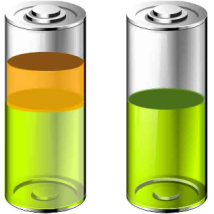Cell Balancing in a Battery Pack
In today’s world, a number of applications require rechargeable batteries as an energy storage element. For high voltage and power rating, many batteries suppliers have done many experiments to increase the cell voltage and its capacity. However, It is not technically possible to increase the individual cell voltage and its capacity due to chemical characteristics and structural problems. Therefore, to meet the required high voltage and power demands of a particular application, multiple cells are connected in series and parallel configurations.
What does ‘Cell Balancing’ mean?
Cell balancing refers to techniques that maximize the capacity, runtime, and the lifetime of a battery pack, that consist of many cells in series and parallel.
The device which is used in a battery pack to balance the cells is called a battery balancer or battery regulator.
Cell balancing algorithm can be based on the following criteria:
- Individual series cell voltage
- Individual series cell impedance
- Individual series maximum capacity
- Individual series cell state-of-charge
Why this imbalance occurs in a battery pack?
In the parallel configuration of cells, which have the same voltage and state of charge (SOC) naturally.
However, in the case of the series configuration of cells, this phenomenon of the same voltage and state of charge (SOC) are not naturally possible many times due to cell imbalance.
Cell imbalance among series-connected cells can occur due to differences in their internal resistance, capacity, charge/discharge rate, ageing characteristics, and many others factors.
This all happened due to manufacturing variances, assembly variances and their uneven ambient temperature.
Why is cell balancing needed?
We know that in a battery pack the cells are not individually charged and they are simply charged by applying a voltage or a current to battery pack terminals.
Due to cell imbalance in a series configuration as discussed above, a cell will not be able to reach full charge all at the same time.
Since some cells reach full charge before others are not charged fully, the charging stops and in this case the battery pack will not contain the amount of energy that it can store.
That’s why the cell balancing is needed to maximize the capacity, runtime and the lifetime of a battery pack.
Example:
In this example, we will understand the cell balancing problem and the way to solve it. There is no problem when all cells are 99.9% charged at the point of the battery pack stops charging.
The problem is that this imbalance increases over time and after many charging and discharging cycles the battery becomes unusable. This phenomenon is explained in the following example.
Let’s assume that a battery pack is made by two cells in series, for the better illustration of the concepts both of them drawn next to each other. This concept is also applicable for the battery with hundreds of cells in series and in parallel.
The battery pack which is made by two cells in series stops charging when the first cell is full and in this case, both cells will contain different amounts of energy as shown in below figure 1.

https://www.powersystemsdesign.com/digital-issues
Figure 1: Usable energy (green) after the first charge without balancing
The cell on the left-hand side is fully charged, while the cell on the right-hand side is not. During discharge, the cell on the right side is completely discharged first. To avoid damaging the battery, the discharge must stop when the cell on the right-hand side becomes empty.
In this case, there is a particular amount of energy is left in the left-hand side cell (the amount of gold as shown in figure 1). This energy is stranded in the battery.
Now, when the battery is recharged, the mismatch is further increased and after enough charge-discharge cycle of the battery pack, the cell on the right will be nearly empty and stop working. So we required the cell balancing to avoid this problem.
Methods of cell balancing:
There are the following methods of cell balancing:
- Active cell balancing
- Passive cell balancing
In passive cell balancing, the extra energy available in the most charged cell is dissipated through resistors as heat.
In active cell balancing, the extra energy available in the most charged cell is transferred to the least charged cells by using dc-dc converters.
There are the following three topologies that can be performed by the dc-dc converter for cell balancing:
- Cell to battery
- Battery to cell
- Bidirectional
Passive cell balancing is a simple, low-cost solution, but it is very slow and not preferred for fast operation.
Whereas the active cell balancing is fast compared to passive balancing but it is a complex and high-cost solution for cell balancing.
References:
- https://ieeexplore.ieee.org/ielx7/63/6824280/06671452.pdf?tp=&arnumber=6671452&isnumber=6824280
- http://www.powersystemsdesign.com/digital-issues
- https://training.ti.com/what-cell-balancing
- https://en.wikipedia.org/wiki/Battery_balancing
AUGUST 13, 2018 AVICHAL JANGIR





